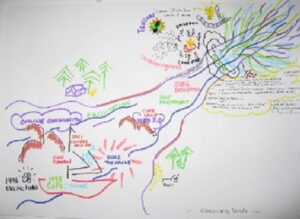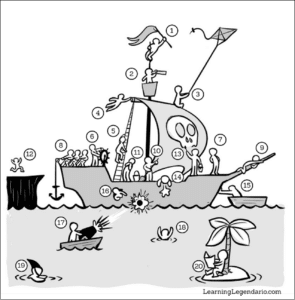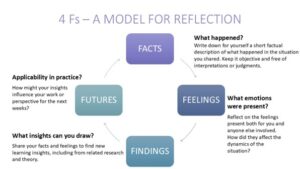Resources to help reflection and discussion about relationships
Introduction
During the Relational Practice Peer Learning Programme, which took place online during 2023, we used a number of ice ‘melters’ and games to build relationships with each other and help us reflect on the relationships we were building with others. Many of these use the power of metaphor to reveal deeper insights in more imaginative and relatable ways. In this blog we’re sharing a few of the ideas that we found most helpful and some other resources that might be useful.
Unique or Shared? The Flower Activity
A good way to build connections with people is to find out what you have in common. It’s also interesting to find out what’s unique about people you are meeting for the first time or want to know more about! The core of this activity is to get into small groups (about four or five people) and introduce yourself to each other. In the conversation you are looking for two types of things – aspects that are unique to one person in the group and aspects that are shared by everyone.
If you are working face-to-face, you can draw a daisy flower shape on a flip chart and write the unique aspects about each of you on the petals and the common aspect in the middle. (You can do this online if you have access to Miro or the Whiteboard function in Zoom, for example.) If you are part of a larger session, each small group can feed back to the big group their common aspect. You can also reflect on how this activity helps build relationships between people.
There’s a version of this exercise at https://www.sessionlab.com/methods/common-and-unique, which is a good source of ice ‘melters’ and other activities.
How did you get here? The River Exercise
This exercise is useful in a number of circumstances – when you have a new group that will be working together for some time, or you have new members joining an existing group/ team and want them to be able to connect with what’s gone on before. The core of this activity is to draw a river which describes your journey (or the journey of your team or project) to now, and how it might flow from now on. Use your Geography GCSE to describe the rapids, whirlpools, meanders and ox-bow lakes you have experienced along the way!

This picture comes from https://trainings.350.org/resource/river-of-life/.
If you are doing this as an introductory exercise for a new group, then each of you will do this on your own; if you are doing this to help a group bond, you might select people from different departments/older or newer team members and each group draws the flow of the organisation or project as they see it. After everyone has completed their drawing, go round the individuals/groups and get them to describe their river of life.
If you are doing this online, you can either get people to draw at home and then describe their drawing to the group, or if you have access to Whiteboard, you can post an image of a river and get people to annotate it with sticky notes.
Where are you now? The Pirate Ship Exercise
The Pirate Ship Exercise generated a really rich discussion when we did it on the Peer Learning Programme. The core is to ask people to identify which person they are on the diagram below, and why, in relation to the project or work that they are involved in. If you know where you are, and where other people are, you can build better relationships with them! This is an ideal one for online sessions, as all it takes is one person to share their screen, and to ask people to start to talk.

What happened and how do we feel about it? The 4Fs Exercise
There are many types of “After Action Reviews” which can be used to review and reflect on a project, an event or a meeting. This one from Greenaway (1992) is useful in relational work because it prompts you to articulate how you are feeling about what happened, as well as what you are thinking about it. This enables you to develop a deeper set of findings and future plans.

Where can you find out more?
There are lots of online sources of group exercises, team work ideas etc. that could help you build better relationships. Examples include:
- Liberating Structures – a website containing ideas to shift the way we work together to increase engagement and distribute power: https://www.liberatingstructures.com/
- Ideas for Storytelling – resources from an event to encourage the use of story as well as facts and figures in our work
- The Permissions Game – a resource from The Relationships Project to help us explore the rules and norms that influence how we work and what we prioritise: https://relationshipsproject.org/permissions-game/
Darley, D., Blundell, P., Cherry, L., Wong, J. O., Wilson, A. M., … Vaughan, S. (2024). Breaking the Boundaries Collective – A Manifesto for Relationship-based Practice. Ethics and Social Welfare, 18(1), 94–106. https://doi.org/10.1080/17496535.2024.2317618
Greenaway, R. (1992), Reviewing by Doing, Journal of Adventure Education and Outdoor Leadership. http://www.reviewing.co.uk/articles/2rbd.htm#4stage accessed 25/7/18
Below you can watch the recording of our webinar accompanying this blog.
This blog is part of a series of resources drawing on the peer learning programme and containing young people’s views, evidence and case studies of why working relationally is important for practice with care experienced young people.
